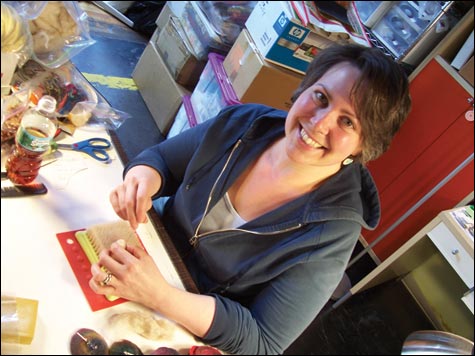
LIZ SMITH, who currently works on the industrial site, thinks the artists can handle the challenges.
|
“That’s where I want to live,” says Maxine Farkas, a painter at Western Avenue Studios (WAS), artists’ workspaces housed in two buildings — the A-Mill and the so-called main building — on an old mill complex in an industrial section of Lowell. She’s pointing toward the far end of a sea of open space interrupted only by some columns and a ladder. This is the first floor of a portion of the complex the artists are not using called the G-Mill, which Farkas says hasn’t seen a tenant in “2.5, going on 3 years.” WAS wants to fill the G-Mill with live/work lofts for 48 artists.
Unfortunately for Farkas, she won’t be moving in anytime soon. Back in January, the Lowell Zoning Board of Appeals (ZBA) denied WAS a special permit for the lofts. (An updated proposal was filed this past month and is on its way to the Lowell Planning Board for a June 16 hearing; the ZBA would still need to approve a special permit for the project to move forward.) The rationale for that decision largely had to do with conflicts the board presumed would arise over traffic and noise between the would-be resident artists and the industrial/commercial tenants located in the surrounding area. One of the board members also mentioned that the area was too dirty, smelly, and noisy for creating art.
Naturally, those artists who work from the complex —there are currently 160 in the A-Mill and the main building — took offense.
“We’re already here living with this. I don’t know if they’ve ever visited,” says Liz Smith, a crafter of handmades selling under the name “Made in Lowell”. Smith, who has graciously agreed to be my tour guide for the afternoon, needles felts as she talks in her studio on the third floor of the A-Mill. “I understand the challenges of living in an area like this, but I think people as intrepid and open-minded as artists can handle it.”
To Smith’s left are her wares — a basket of handmade beads, gorgeous decorative eggs with intricate patterns, felt and rope bracelets. I notice a few paintings hanging on a wall. She tells me they’re not for sale. “That’s the art I do for myself.”
WAS is essentially rented office space for artists. But because it is filled with such people, it isn’t like any office building you’ve ever seen before. Turning out of Smith’s studio into the hallway, I encounter everything from mixed-media and video installations to WAS artist Rex McManamy’s “Vendzart” — vending machines rigged to dispense art.
While perusing, we run into Farkas. “I was just downstairs choosing where to get dirt from,” she says, alluding to a new idea McManamy has had for a Vendzart machine that would shoot soil, ostensibly from all over the world (but not really), from its slots.